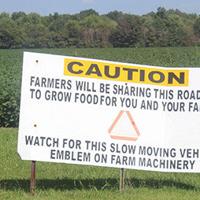Farming and accidents have long been intertwined. The Occupational Safety and Health Administration places agriculture 10th on its list of most dangerous professions.
According to OSHA, the fatal injury rate for farm-related accidents is 20.9 per 100,000 workers, largely attributed to accidents involving heavy machinery.
As technology advances, safety remains a consideration. Some, however, fear that it is not stressed enough.
Salah Issa, a University of Illinois professor with a concentration in agricultural safety, is hopeful that safety measures for 21st century technology will catch up much quicker than that for 20th century technology. But he has concerns.
“I feel that we are replicating that time in the early 1900s when there was so much excitement about what technology can do, with almost every single university and company talking about how all these wonderful robots are going to pull weeds, do cover crops and so on,” he said.
Issa pointed out that though tractors were introduced around 1900, rollover protection was not commonly included until the 1970s. A European study indicates that about half of all tractors in use today still are not equipped with ROP.
“It’s sad because we still have deaths and injuries due to lack of ROP,” he said.
The march toward autonomous vehicles continues, spurred in part by a labor shortage.
John Deere recently rolled out a line of three self-propelled forage harvesters. The company said in a release that the models address the needs of products “challenged by increased operating costs, shorter harvesting windows and a small pool of skilled workers.”
Other manufacturers have ramped up production of self-propelled and robotic machines. The adoption of such equipment highlights safety issues.
“As we adopt more autonomous vehicles we have to be thinking of safety,” said Josie Rudolphi, director of the North Central Farm and Ranch Stress Assistance Center. “Auto-steer is amazing technology, but it can lead to farmers to keeping an eye off what’s in front of them.”
People are also reading…
Safety has not been addressed sufficiently in the wake of changing technology, Issa believes.
“There hasn’t been a lot of conversation on how this technology will interact with humans,” he said. “We think of manufacturing facilities where we install robots, and there are walls all around. That’s not possible with agriculture. There are going to be human-machine interactions in the field.
“It can be as simple as kids running into the field when a robotic machine is doing its job. There is a whole spectrum of human-machine interactions that occur on the farm. That needs to be discussed as we’re introducing all these technologies.”
Rudolphi points out that many injuries are traffic related.
“When farm vehicles meet non-farm vehicles, there can be accidents,” she said. “What’s happening on public roads is important. That requires education on both sides. We need to be sure that non-farm people are aware of how slow farm vehicles travel, and that they practice patience.”
My biggest fear is that as we’re moving into these highly sophisticated systems, we’re moving out farther from rural communities into cities,” he said. “How is that impacting things and the avoidance of that?”
Rudolphi also pointed to modern communication technology such as cell phones, which can cause distractions during farm work.
The discussion of dangers on the farm inevitably includes mental health. While farmers don’t face the same economic stresses as they did in the farm crisis of the 1980s, stress is a constant threat.
“We’re always concerned about stress and mental health,” Rudolphi said. “We need to make sure farmers are surrounding themselves with people who can offer positive social support.”
The center she directs is equipped with resources such as a help line and referrals for professional assistance. Unlike during the 1980s, farmers are dealing with relatively positive economic signals. But stress is still prevalent in agriculture.
“We want to make sure that our farmer supporters are well-trained on mental health literacy and are able to provide support if they need it,” Rudolphi said. “Economics continue to perplex and stress producers regardless of commodity situations.”








Gloss